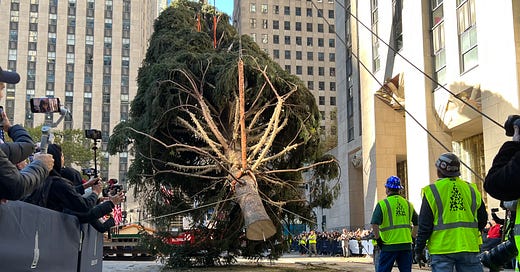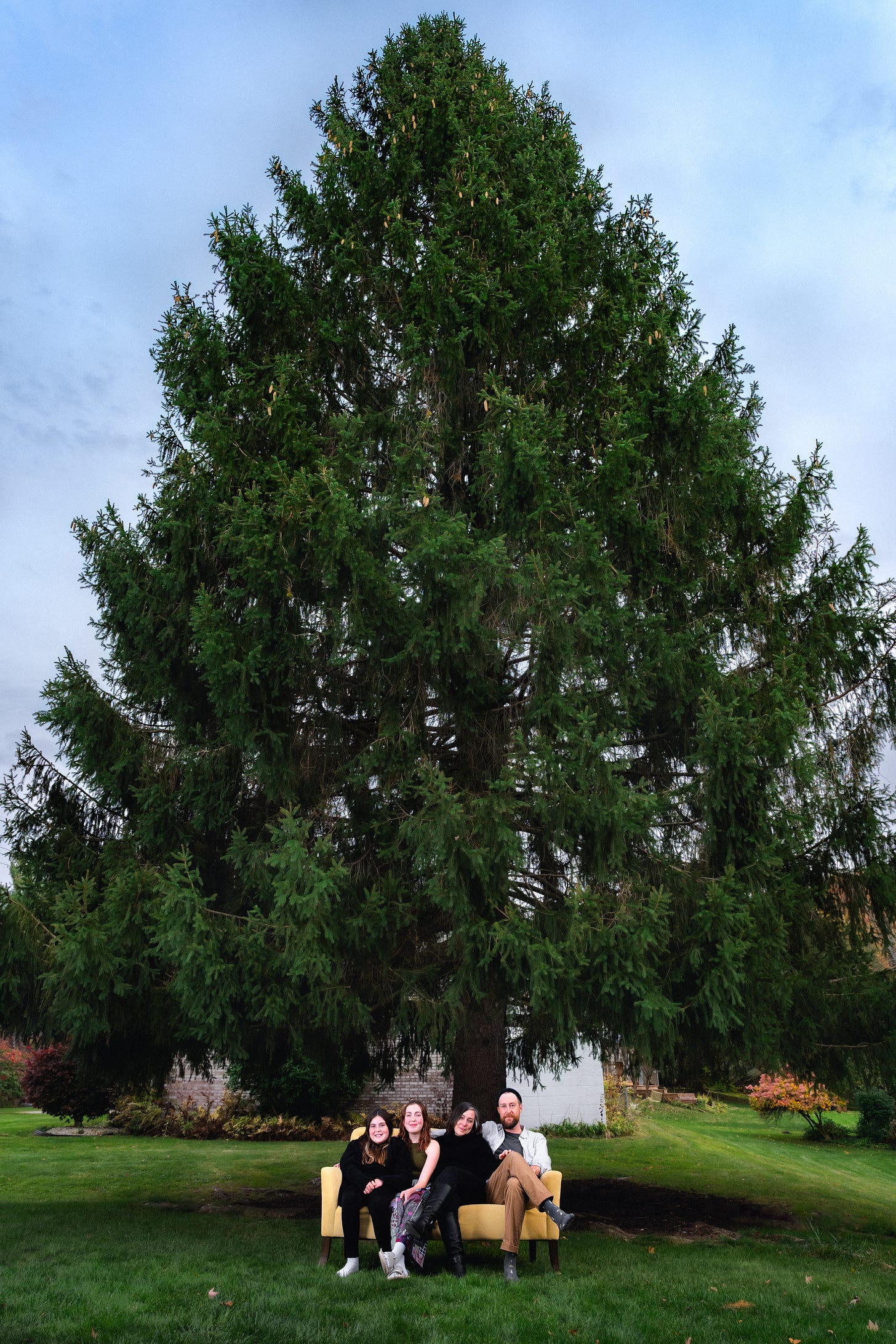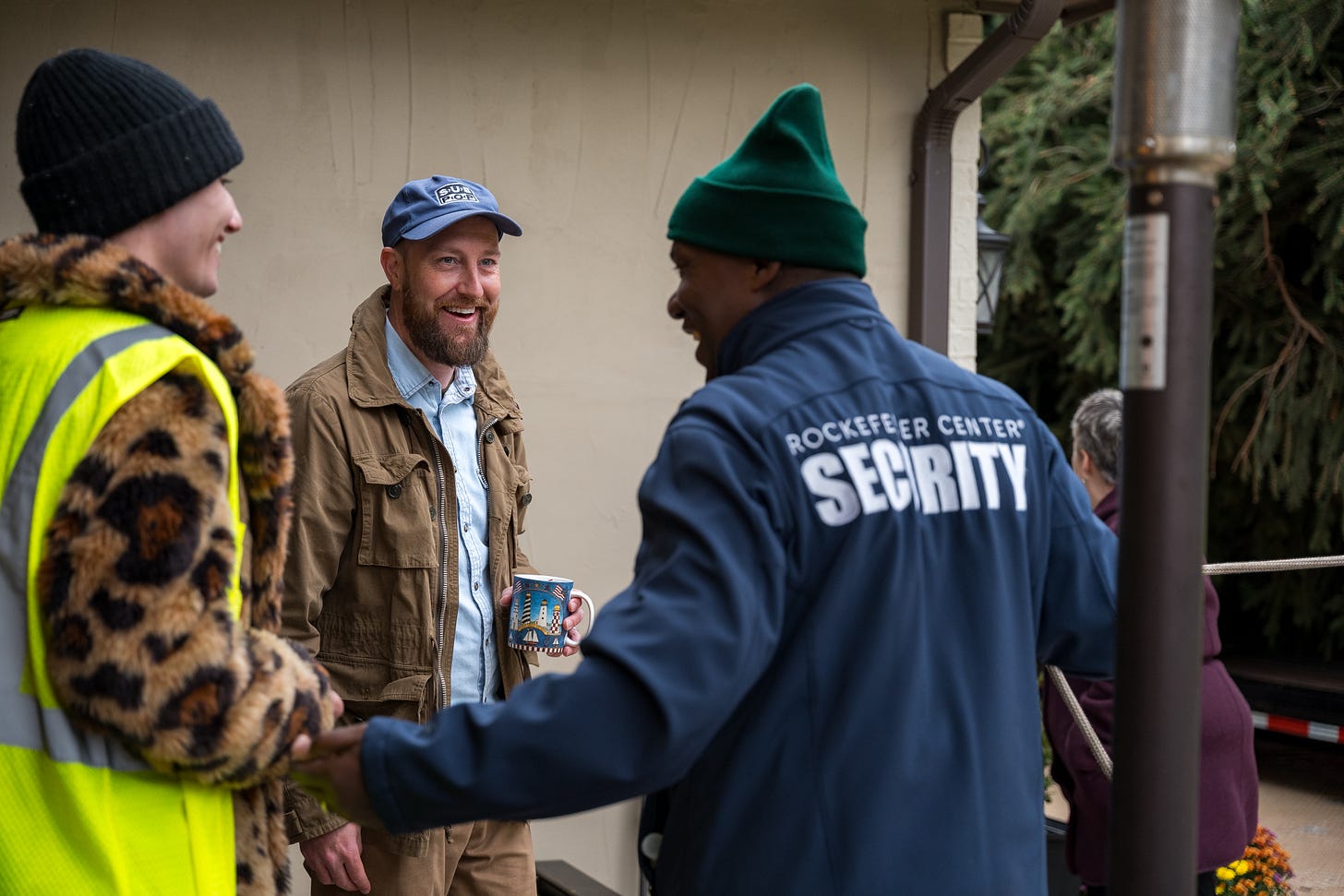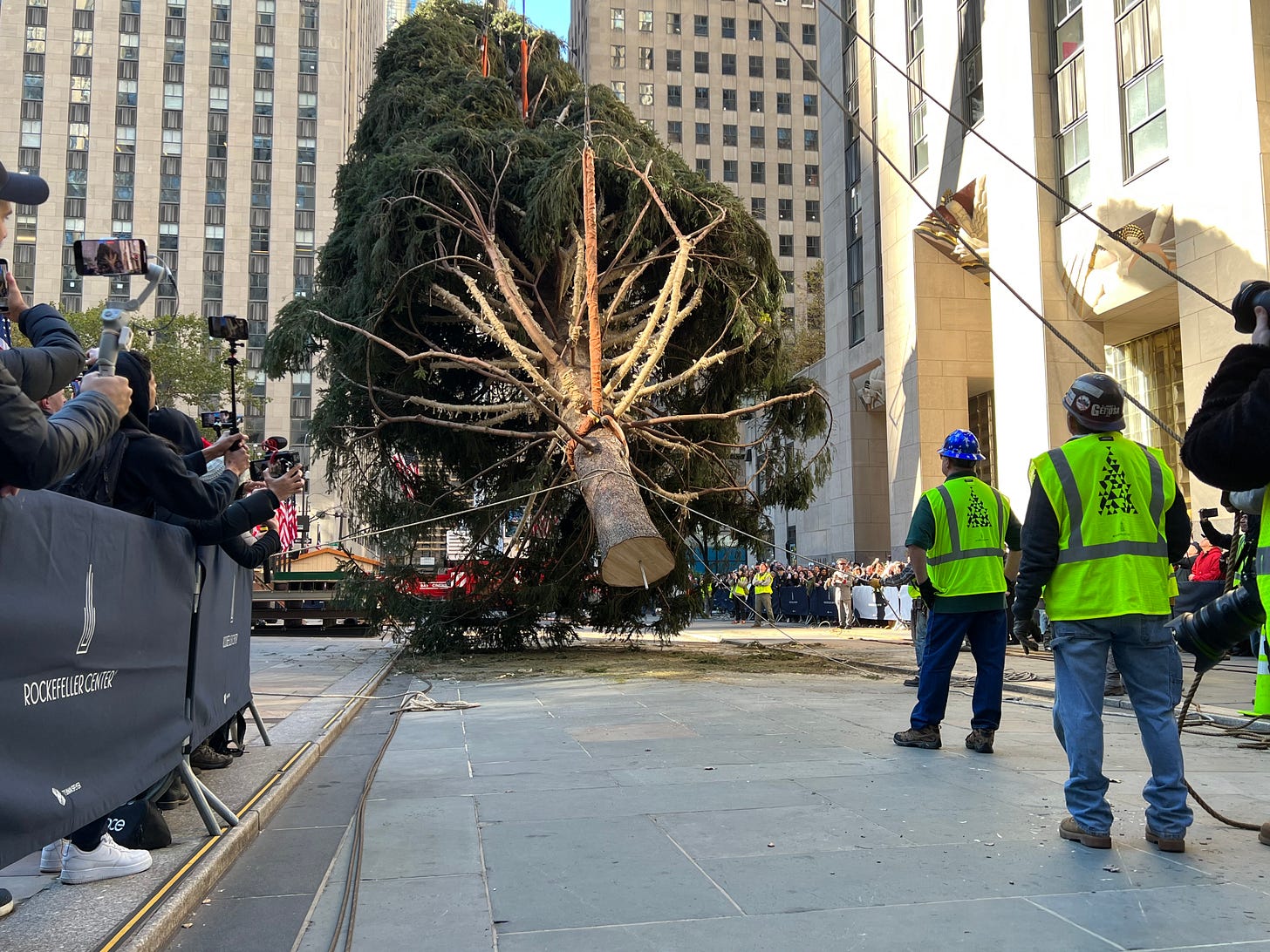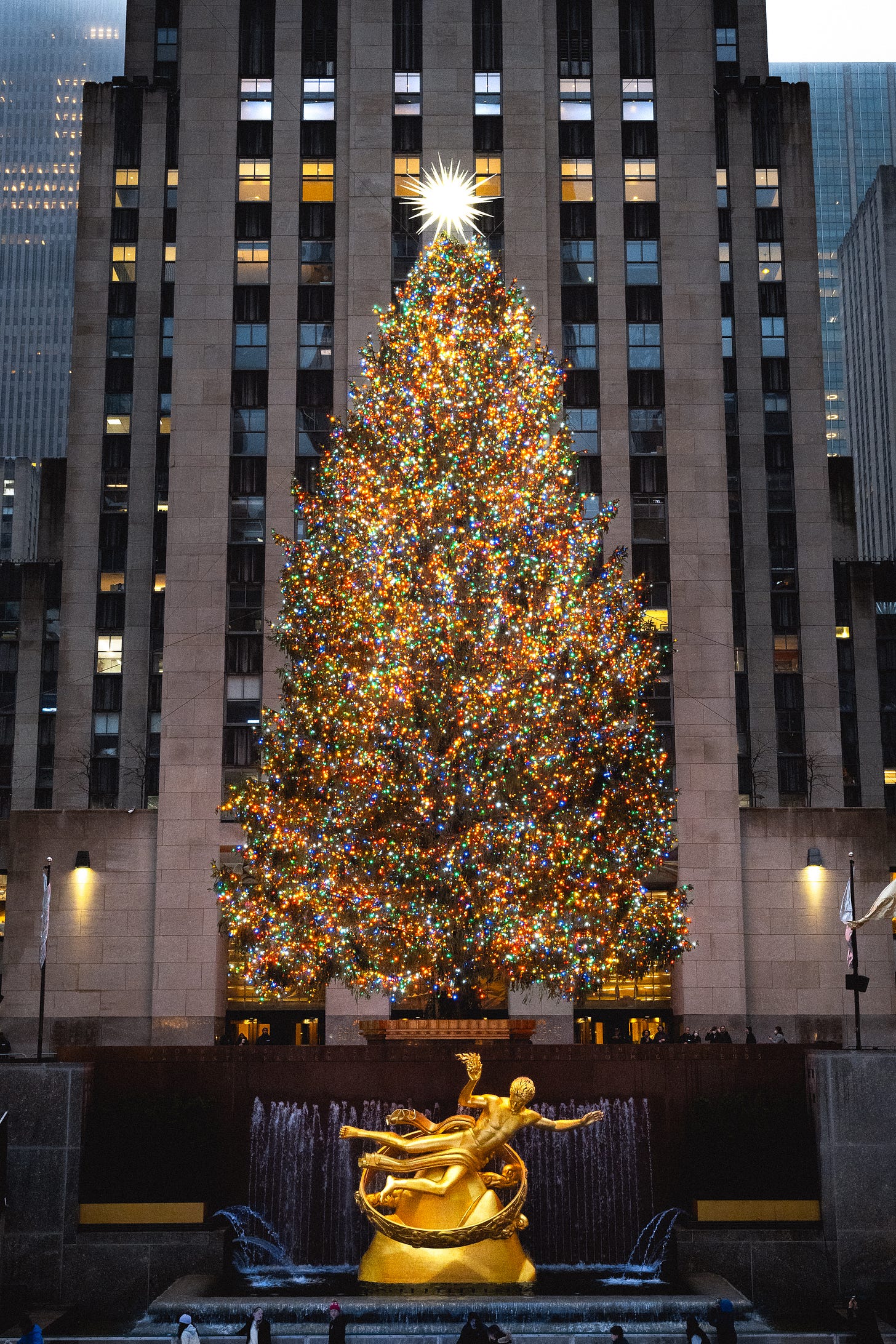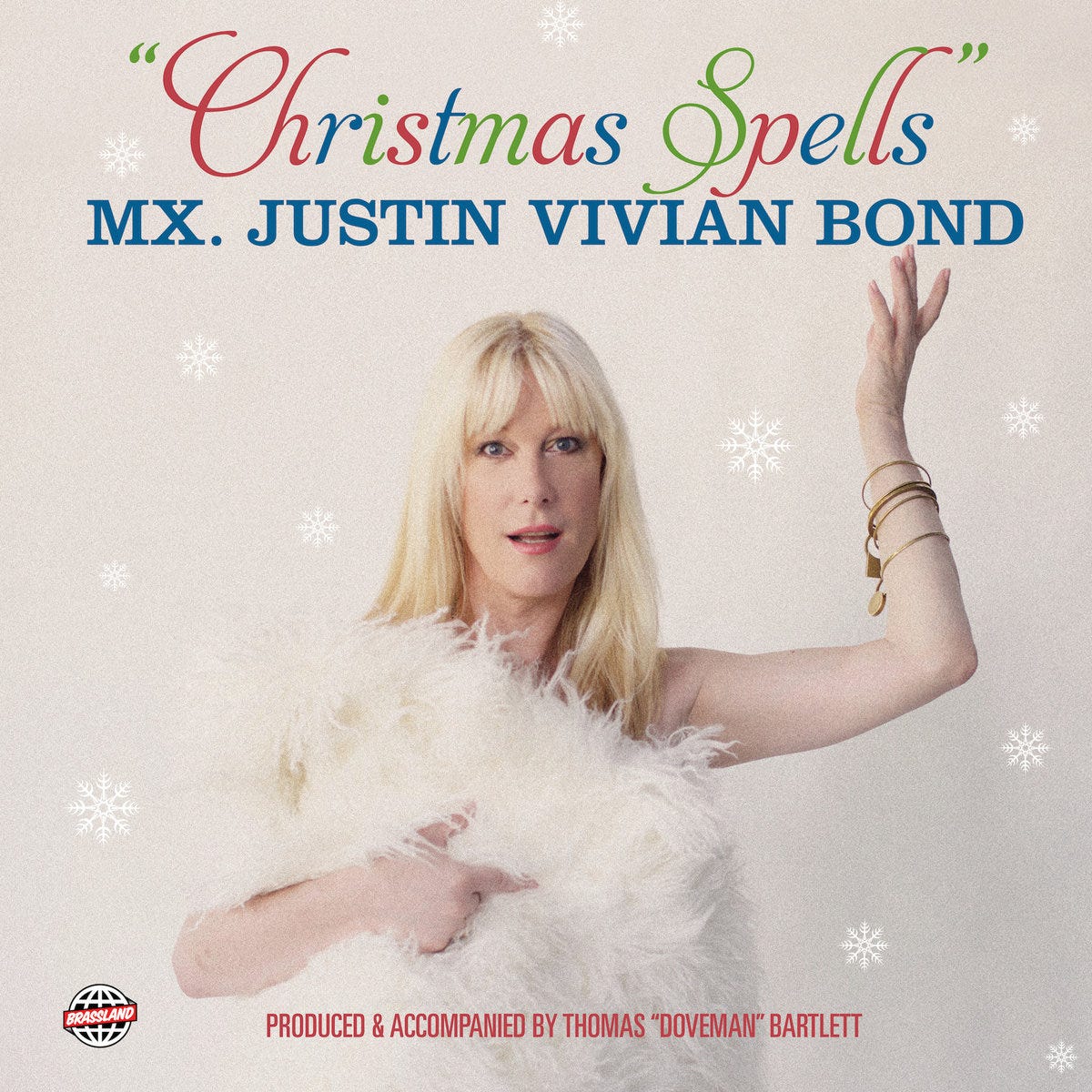A musician who tended this year's Rockefeller Center tree shares his fairytale of New York
Matt McGinley's journey from pop-punk to podcasts to accidental spruce farmer. Also: a perennial holiday mixtape and the death of Shane MacGowan.
Here is the origin story of America’s most iconic Christmas tree. Well, at least this year’s edition—a 12 ton, 80 foot tall spruce sourced from an unsuspecting family in upstate New York. When I discovered that I knew1 the musician who donated it, I asked if he would share his story with my mixtape delivery service.
May you enjoy Matt’s real life fairytale of New York.
The origin of this year’s Rockefeller Center Christmas Tree
The narrative of Matt McGinley’s career in music was already…eclectic. The band he co-founded benefitted from the pop-punk gold rush of the ‘00’s and ‘10s landing a song in Spotify’s so-called Billions Club.2 He’s gone on to become a go-to composer for some of today’s best outlets for audio storytelling. He started big doing work for the show that embodies the NPR style, This American Life, and later expanded into scoring genre-defining podcasts like Serial, S-Town, Nice White Parents, etc.
Well, thanks to some holiday serendipity, Matt’s story has taken another odd twist. What follows is a quick chat about the details:
Alec Hanley Bemis: A large tree on your property was chosen as this year’s Rockefeller Center Christmas tree. The obvious question is “How did this happen?” Did someone from Rockefeller Center slide into your DMs? Leave a note on your porch?
Matt McGinley: Yeah, so it was a stroke of luck and circumstance. In June of 2023, my youngest daughter and I were backing out of the garage when a stranger pulled into our driveway. We got out of our cars. He introduced himself as the head gardener of Rockefeller Center and asked if he might be able to look at the tree. I remember just laughing because I assumed it was a joke.
I live in New York’s Southern Tier3—which is like 180 miles from Manhattan. None of it made sense to me, but it also seemed like an unlikely thing to fabricate. So I said "Okay” and then my daughter and I left.
We returned a short while later, and the gardener was still there studying the tree. I told him that I’d always assumed that they have, like, a farm for these things. He said that’s not how it works—and that he pretty much just drives around the Northeastern United States looking for them. He took some pictures and then left.
AHB: When did you know your tree had actually been selected as the One?
MM: I wouldn't say there was an actual moment of selection—it was more like a gradual understanding. The gardener came back the following week. And the week after that. And then nearly every week between July and November—driving three hours from Rockefeller Center to tend to the tree.
The work on the tree began in July. Pruning it, mulching it, feeding it with a kind of water that clearly had more than just water in it. Sometimes he’d bring other folks along. The crane operator. The landscaper. The rigger. The lawyer.
We immediately assumed it was on a short list of other spruces. But for the first few months it was pretty unclear to us whether the tree would be chosen. It did seem unusual they would spend so much time tending to ours. Still, we never inquired directly and were more or less happy to have some free mulch.
In late September, we were given a schedule of dates they hoped we'd be available for. i.e. the cutting, the arrival at Rockefeller Plaza, the lighting.
That clarified things.
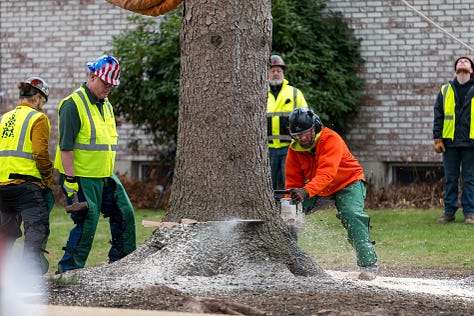
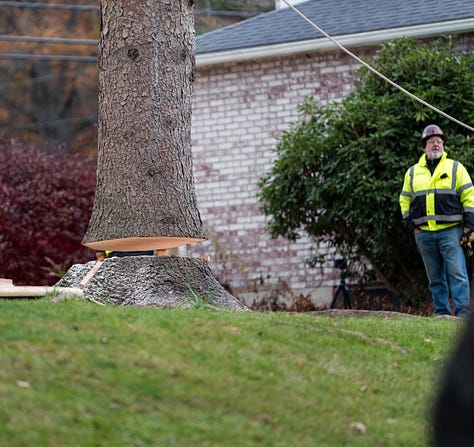
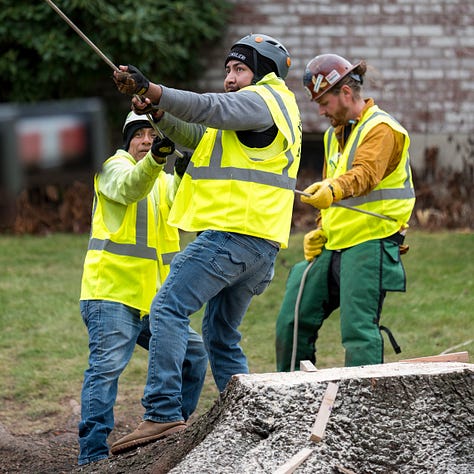
As you might guess, transporting an 80-foot spruce is a bit of a process. Up until a week before the cutting takes place, the whole thing is pretty secretive. I guess you would call it on a need to know basis. When an executive was driven from NYC to visit the tree over the summer, the gardener met them at a nearby Denny’s so he could bring just the executive the rest of the way without the car service driver knowing the tree’s location.
About a week prior to the cutting, the press are informed where the tree will be coming from and our backyard took on a new energy. 24/7 security at this point. Cars slowing down and pulling over constantly. Folks getting out and taking photos with their entire families.
Behind the scenes, there was a crew of eight workers up in the tree—sometimes all at once. They tie each branch by hand which are then winched up against the trunk so it’s narrow enough to fit on the interstate. In the mornings, we’d fill a cooler with water and Gatorades, light up a fire pit in the yard for them, and leave music playing out loud. I feel bad that I never asked them what they wanted to listen to. Most of the workers were from New Jersey so I chose a lot of Bruce and Bruce-adjacent music. I also tried The War on Drugs, because they’ve always seemed to me like a band Bruce fans would like.
AHB: Was there any reluctance to give up your tree and invite the hassle? In the press I’ve read,4 it says this was a donation, so there was no direct financial incentive.
MM: It was a pretty easy decision for us. Our family got to enjoy the tree for awhile—and now many millions of other people will. And then in January when the tree comes down, it’s milled into lumber and used to build homes in partnership with Habitat for Humanity. What a life for a big spruce tree that my dogs used to pee on!
They do come back in the spring and kind of repair the yard which involves grinding the roots and stump out, regrading the landscape, and then planting a bunch of arborvitae in its place. Honestly, it’s generous and much more than they needed to do.
AHB: Sometimes we play a game with our kid called rose / thorn / bud. We name the best thing about the day (the rose), the worst thing (a thorn), and something thing to look forward to (a bud). Could you do an equivalent with this experience?
MM: I love that! We have a similar way of recapping the day with our kids called peak, pit, and funny business.
The rose in this experience was the head gardener. Months ago, he was a stranger in my driveway, but eventually he became the kind of friend who knows where your spare keys are. He’s eaten Sunday dinner with us as a family. He’s basically helped the kids get off the bus a handful of times.
The gardener’s name is Erik Pauze (though his crew call him Pancho) and it’s his show. It’s his 35th year working "the Tree”—which means 35 years driving a rented, midsize SUV around the Northeast trying to happen upon a huge, perfect Norway spruce tree. Without him, Christmas doesn’t come to Rockefeller Center Plaza. His employers told us that when he wants to retire, he’ll need to give them ten years notice. Presumably they’re joking?
Also, he didn’t ask me questions about being a musician, which I always appreciate. Mostly we talked about soil conditions, weather factors, how almost everyone calls what drops from this tree “pine cones” but they’re actually spruce cones. But we also talked about our kids. We talked about reality television. We talked about death and loss.
The holidays will pass and so will the excitement around the tree. But it’s my good fortune to have developed friendships through this experience. (Another example is the guy you see running his hand along the tree in this video. He’s the head doorman at 30 Rockefeller Center. Everyone refers to him as the Mayor of Rockefeller Center. But after this, I know to just call him CJ.)
A thorn: I think I suffer from the syndrome of always look forward never ever look back. So, it stung to have someone send me a piece of press where the headline was like “Drummer from Gym Class Heroes Donates Tree.”5 It minimizes a decade of stuff that I’ve done since. Like touring/playing drums for other artists. Or my work with Wegmans, a multi-billion dollar brand and regionally treasured grocery store chain.6 Or the segment of my career that I feel most deeply connected to which is composing music for podcasts and radio shows like This American Life, which enables emotionally complicated, often delicate stories to be told.7
I don’t want to cut down my old band (no pun intended!) or what I contributed to it, however it’s no longer my identity, or the majority of my career. Listen, I get it, that headline works better for music blogs than the less sexy “Composer For Beloved Public Radio Shows Donates Spruce.” I’m just saying, scratch the surface…
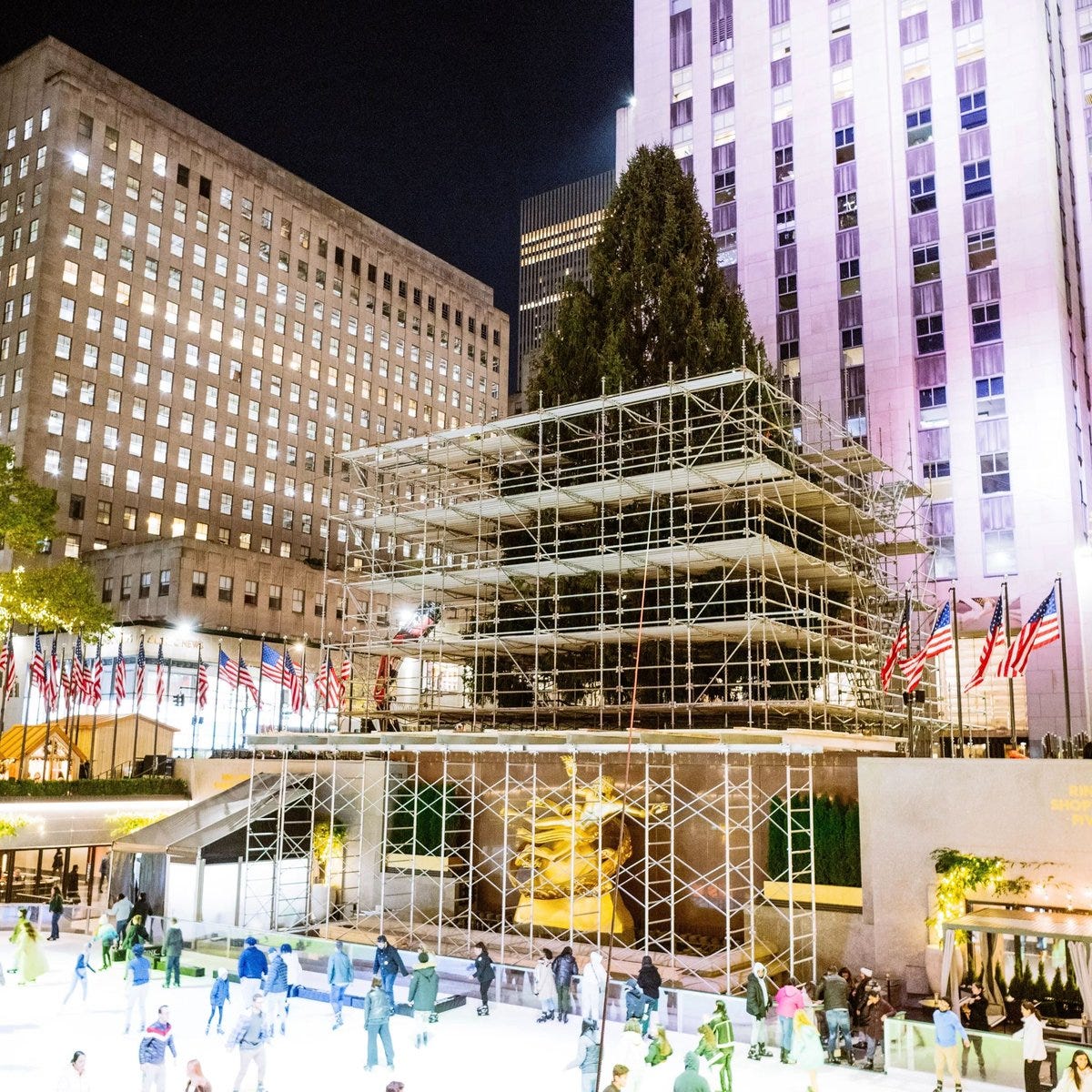
A bud: I don’t know if this thought lives here or not, but sort of a forward looking takeaway that occurred to me is that…the Norway spruce isn’t even native to this area. Someone had to plant this thing a long time ago. And then for years it was just…there. Doing the hard, tedious work of getting bigger—but so slowly that you’d probably never notice.8 Just quietly growing in the background.
It reminds me of a career in music, and how most of the real work happens out of view, over a long period of time. If you’re lucky and you stick around long enough and if the conditions are right and if you don’t let the storms snap all of your branches or strip the bark from you…then once in a while, the improbable happens and you get to play the big stage.
There’s a randomness to it. The thing we can control is, we decide to plant the seed.
I try to be Buddhist about the notion of “what makes it into my obituary.” Or, to tie things directly to your experience, I try to focus less on “how I’ll be remembered” and more on how plants will re-use my nitrogen…
You didn’t have much agency here beyond offering a generous “YES!” when asked, but have you considered how this alters your legacy? Or at least how your kids think about their parents now, and their own place in the world?
I’ve always been drawn to things that allow me to play a small part in something much bigger. So in some ways, this isn’t dramatically different.
As far as how this plays into my own legacy, we’ve taken on a mantra in our house, which totally makes the kids eyes roll out of their heads at this point. But it’s true: none of this is about us, it’s about a tree. It’s been a useful way of reframing our experience—reminding us to focus on being of service, of giving without an expectation of getting. It’s also great to remember when we’re a little tired of the attention. What a curious, fascinating tradition. And here we are playing our part.
If you’d like to follow Matt McGinley he’s on Xwitter, Instagram, and Bandcamp — and this is his website. All unattributed photos by Matt Ebbers.
Some holiday tunes. Really! Again!
# of Tracks: 50ish
Length: 3 hours
Themes: a sorta indie Xmas ~ a very Brassland Xmas ~ an observance of the solstice ~ built around selections from Mx. Justin Vivian Bond’s House of (Holiday) Whimsy
Link: Spotify — Apple Music — YouTube
Here’s a reprise of the evergreen holiday playlist I circulate at this time of year. If you want more context, here’s a post about it from 2021.
People Who Died: Shane MacGowan
Shane MacGowan was a songwriter’s songwriter.9 And the timing of his death in late November was especially poignant, since his most enduring contribution to popular music at-large is the holiday perennial which is referenced in the intro to this post. Here’s Shane’s rendition, a duet with Kirsty MacColl backed by his best-known band The Pogues.
Is it possible to out-do that original? Probably not. But this spirited take by Glen Hansard (Once, Swell Season, The Frames) and Lisa O’Neill at Shane’s funeral sure takes an honest go.
After seeing the dancing in the aisles which Lisa and Glen inspired, well, may we all be so lucky as to have an Irish funeral. And may this be the last Irish funeral for a well-known musician we’re asked to click on for some time.
Our personal connection is…very random. Early in 2022, I noticed he’d 👍 a post about Bartees Strange’s LP of The National covers. When I saw his kinda confounding background (crossover pop-punk » NPR composer?) I was…well, totally intrigued. I reached out via DM, apologizing for “using Twitter like LinkedIn” (even if the Internet has, at this point, been optimized for surveillance capitalism). We got coffee near my house and occasionally I’ll text him with questions about spiedies and garbage plates while driving through upstate New York.
The Billions Club is an actual thing on Spotify.
Matt’s band was Gym Class Heroes. As of this writing, their collaboration with Maroon 5’s Adam Levine “Stereo Hearts” has 1.2 billion Spotify streams. By comparison the YouTube video has been viewed a paltry 779 million times:
Currently existing somewhere between inactive and defunct, a version of the band will perform at the When We Were Young festival in autumn 2023.
Think state universities, the rust belt, and basically being part of Pennsylvania.
…and watched. NBC’s Today Show devoted a segment to Matt’s family. I’d like to think I went a bit deeper in this chat with him.
McGinley established creative guidelines for how music and sound are deployed across the entire Wegmans’ brand. The chain is, indeed, a thing, especially upstate. When the first one opened in Brooklyn in 2019, the New York Times headline read “Wegmans Opens in Brooklyn; Fans Wait in the Rain, and Rejoice.”
Beyond making music for the definitive public radio show This American Life, McGinley’s made music for Serial, S-Town, The Trojan Horse Affair, We Were Three, and Nice White Parents, among others.
Some proof that this family actually noticed the tree. That’s Matt knocking dramatic amounts of pollen out of it with a tennis ball.
A songwriter’s songwriter indeed. When Shane died he was notably memorialized by Bruce Springsteen who wrote “His music is timeless and eternal. I don’t know about the rest of us, but they’ll be singing Shane’s songs 100 years from now.” This wasn’t the first time Bruce had nice things to say about him:
Finally here are Nick Cave’s thoughts, from a kind of thought leadership conference that occurred just after Shane’s passing. He notably focuses on his peer’s kindness:

